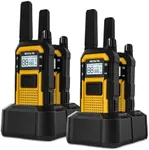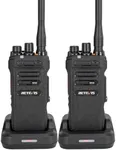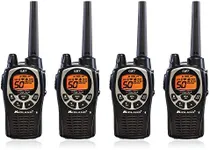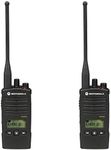Buying Guide for the Best Walkie Talkies Long Ranges
When choosing a walkie-talkie for long-range communication, it's important to consider several key specifications to ensure you get a device that meets your needs. Walkie-talkies are essential for various activities such as hiking, camping, and professional use in large areas. Understanding the key specs will help you make an informed decision and select the best walkie-talkie for your specific requirements.RangeThe range of a walkie-talkie indicates the maximum distance over which it can communicate effectively. This spec is crucial because it determines how far apart users can be while still maintaining clear communication. Walkie-talkies typically have ranges from a few miles to over 30 miles. For casual use in urban areas, a shorter range may suffice, but for outdoor activities like hiking or professional use in large open spaces, a longer range is necessary. Consider the environment where you will be using the walkie-talkie to choose the appropriate range.
Frequency BandsWalkie-talkies operate on different frequency bands, mainly FRS (Family Radio Service) and GMRS (General Mobile Radio Service). FRS walkie-talkies are suitable for short-range communication and do not require a license, making them ideal for family and recreational use. GMRS walkie-talkies offer longer range and more power but require an FCC license in the United States. If you need a walkie-talkie for professional or long-range use, GMRS is the better choice, while FRS is sufficient for casual, short-range communication.
Battery LifeBattery life is the duration a walkie-talkie can operate before needing a recharge or battery replacement. This spec is important because it affects how long you can use the device without interruption. Walkie-talkies can have battery lives ranging from a few hours to several days. For extended outdoor activities or professional use, look for models with longer battery life or the option to use replaceable batteries. For occasional use, shorter battery life may be acceptable. Consider how long you will need the walkie-talkie to operate between charges to choose the right battery life.
DurabilityDurability refers to how well a walkie-talkie can withstand harsh conditions such as drops, water exposure, and extreme temperatures. This spec is important for ensuring the device can handle the environment in which it will be used. Walkie-talkies can range from basic models with minimal protection to rugged models designed for extreme conditions. If you plan to use the walkie-talkie in outdoor or industrial settings, choose a durable model with features like water resistance and shockproof construction. For indoor or casual use, a less rugged model may be sufficient.
Channels and Privacy CodesChannels and privacy codes determine how many communication options you have and how secure your conversations are. More channels allow for more users to communicate without interference, and privacy codes help prevent others from listening in on your conversations. Walkie-talkies can have anywhere from a few channels to over 20, with various privacy codes. For crowded areas or professional use, more channels and privacy codes are beneficial to avoid interference and ensure privacy. For casual use, fewer channels and privacy codes may be adequate.
Additional FeaturesAdditional features such as weather alerts, hands-free operation, and built-in flashlights can enhance the functionality of a walkie-talkie. These features are important for improving convenience and safety. For example, weather alerts can keep you informed of changing conditions, and hands-free operation allows you to communicate while keeping your hands free for other tasks. Consider which additional features are important for your specific needs and choose a walkie-talkie that offers those features.

















